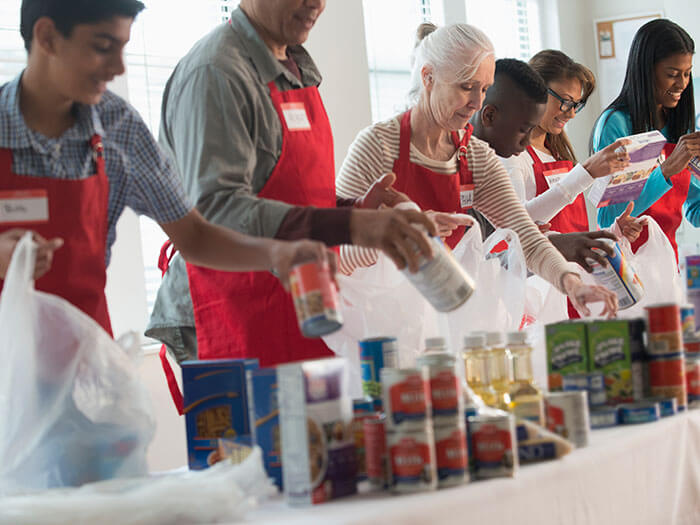
Get to know the charity you’re giving to, experts say
 Volunteering is an effective way to get to know a charity you’re thinking of donating to (Getty Images/Jose Luis Pelaez Inc)
Volunteering is an effective way to get to know a charity you’re thinking of donating to (Getty Images/Jose Luis Pelaez Inc)
There are 85,000 charities registered with the Canadian Revenue Agency (CRA), and it can be hard to know which organization needs your donations the most. And, according to a recent survey, Canadians are more generous than ever with more than half of those surveyed giving an average of $1,000 annually.
Whether it’s helping to support community initiatives, protecting the environment or looking out for vulnerable animals, deciding which charity to support is an important choice, both personally and financially.
If your budget includes room for donations, here are five tips to ensure your money goes to the right organizations. Plus, what to know about the tax implications.
1) MAKE (AND STICK) TO A PLAN
Decide what you’d like to give at the beginning of the year and try to avoid being swayed by the numerous requests received, be it from street canvassers, store clerks or a friend’s birthday fundraiser, recommends Kate Bahen, managing director of Charity Intelligence Canada, a registered charity that assesses hundreds of Canadian charities.
“Think about what matters to you when you’re giving,” she says. And remember that "you have the right to say ‘no thank you’ without guilt, if bombarded by requests.”
Once you set an annual amount, you can also allot a portion for spontaneous donations such as humanitarian emergencies. But Bahen suggests limiting cash donations that can’t be accounted for via tax receipts, credit cards or bank accounts.
2) GET TO KNOW THE CHARITY
Make sure the cause aligns with your values, but that it also delivers on its mandate effectively, says Toronto lawyer Mark Blumberg, partner with Blumberg Segal LLP, who specializes in the non-profit and charity sector.
“A high-profile charity saving polar bears, for example, may be receiving a of lot attention, but there may be a smaller group doing similar work where your money can have greater impact,” he says.
Volunteering is a way to see a charity’s work first-hand, adds Blumberg. “It is helpful in giving donors some idea of how effective the group is,” he says.
Researching a charity’s various functions, including fundraising, activities and programming, can provide insights.
You can also look to outside resources that rate charity effectiveness including Charity Intelligence, Charity Data, Charity Central, Charity Navigator, as well as publications such as Maclean’s and MoneySense.
3) ASK QUESTIONS ABOUT IMPACT
Despite the information available, measuring impact is a challenge, warns Blumberg.
For example, he says, size and notoriety of a charity does not necessarily equal greatest impact. Statistics, Blumberg notes, can also be misleading. For example, communicating the number of people a program reached does not explain how they were assisted.
Given this, don’t be afraid to ask the tough questions to help you get a better idea of how the charity is living up to its mandate and objectives, adds Bahen.
“Good charities will want you to know how they spend your money and the results they achieve,” she says.
4) BE AWARE OF RED FLAGS
Consider it a red flag if a charity isn’t registered with the CRA, doesn’t have a website or contact info for a physical address or accepts cash donations only. Watch out for pushy fundraising tactics as well, such as canvassers insisting you should sign up as a donor right away, rather than taking information and giving it some thought.
From a tax perspective, make sure donations are eligible for a tax receipt that is accepted by the CRA, adds FCPA Bruce Ball, CPA Canada’s vice-president of taxation.
“The key is whether the receipt looks like the CRA examples as there is a requirement to produce receipts in that form,” he says.
When giving large donations, the CRA may require additional information such as proof of payment, adds Ball. “Keep this on hand at the time the gift is made rather than finding it later,” he says.
5) REVIEW DOCUMENTATION
Documentation such as financial statements and annual reports—accessible via a charity’s website, with details also available through the CRA and some charity watchdogs—give clearer insight into a charity’s activity.
Though not required for Canadian charities, audited financial statements, which include accompanying notes and the auditor’s opinion, provide the most transparency, says lawyer Rayna Shienfield, principal, corporate oversight and governance for CPA Canada.
When reviewing financial statements, keep in mind that low administrative costs—which include supplies and equipment, accounting services and funding applications—do not necessarily equal a more efficiently run charity, explains Shienfield.
“There is a misconception that the less money spent on overhead, the better, but it takes money to effectively operate a charity,” she says. “Donors can, and should, look to these documents to ensure that overhead spending is within a reasonable range, but the key here is reasonable.”
With a little research, you can be confident that your donations are used effectively for a cause you believe in.
“There are far more excellent charities out there and [prospective] donors have good ‘spidey senses.’ Listen to your gut and don’t tolerate pressure tactics,” says Shienfield.
NON-FOR-PROFITS IN FOCUS
CPA Canada has a wealth of resources for non-for-profit (NFP) organizations, from effectively measuring performance and managing financial sustainability and digital disruption, to ensuring commitment to accounting standards and adequate annual and financial reporting.